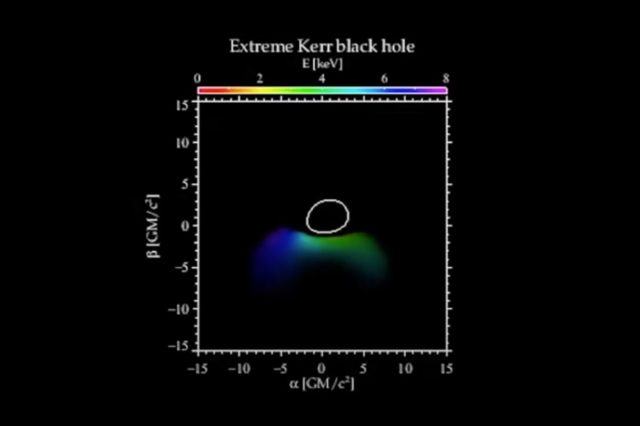Black holes feeding on companion stars can go through cycles where they emit high-energy outbursts. MIT astronomers are using X-ray echoes from those cycles to map out the environment around these exotic objects, similar to how bats map out their environment via echolocation. The astronomers hope to use this new data to learn more about the evolution of these kinds of black hole systems, and by extension, the formation of galaxies, according to a new paper published in the Astrophysical Journal.
“The role of black holes in galaxy evolution is an outstanding question in modern astrophysics,” said co-author Erin Kara of MIT. “These black hole binaries appear to be ‘mini’ supermassive black holes, and so by understanding the outbursts in these small, nearby systems, we can understand how similar outbursts in supermassive black holes affect the galaxies in which they reside.”
As we've reported previously, it's a popular misconception that black holes behave like cosmic vacuum cleaners, ravenously sucking up any matter in their surroundings. In reality, only stuff that passes beyond the event horizon—including light—is swallowed up and can't escape, although black holes are also messy eaters. That means that part of an object's matter is ejected in a powerful jet.
If that object is a star—such as the companion star of a black hole binary system—the process of being shredded (or "spaghettified") by the powerful gravitational forces of a black hole occurs outside the event horizon, and part of the star's original mass is ejected violently outward. This process can form a rotating ring of matter (aka an accretion disk) around the black hole that emits powerful X-rays, visible light, and sometimes radio waves. Those jets are one way astronomers can indirectly infer the presence of a black hole.
The MIT team was particularly interested in systems where the companion star is about one solar mass and exhibits cyclical outbursts in the form of X-ray flashes. Per the authors, most scientists think that a hot plasma located close to the black hole, called the X-ray corona, plays a role in these cycles, but questions remain about how the X-ray corona is formed in the first place, as well as how it evolves throughout an outburst.

The emitted X-rays can sometimes reflect off the accretion disk, creating ‘echoes’ of the initial emission. And detecting those echoes offers an excellent opportunity for tracing how the black hole evolves as it feeds. Specifically, it's possible to estimate the time lag between when a telescope detects light from the corona and when it picks up the X-ray echoes and monitor how that lag shifts as the system works through an outburst cycle.
Astronomers had previously detected X-ray echoes (or reverberations) from two binary systems in the Milky Way galaxy. To hunt for more, the MIT team developed an automated search tool dubbed the "Reverberation Machine" and used it to analyze data collected by NASA's Neutron star Interior Composition Explorer (NICER) on board the ISS. The Reverberation Machine identified 26 candidate black hole binary systems, and of those, 10 (including the previously detected systems) were emitting detectable X-ray echoes.
All of the eight new black hole binary systems emitting echoes ranged from five to 15 solar masses, and all the companion stars were about the size of our Sun. "As far as we can tell, the fact that we only see detections in about half of the black holes is due to their higher quality of data, not because they are particularly unique," Kara told Ars.
What does this new data tell astronomers about how a binary black hole evolves during an outburst? The MIT team was able to construct a reasonably universal picture. The system typically begins in a relatively quiescent state. As material falls onto the accretion disk faster, the X-ray emission also increases in luminosity, dominated by "hard" X-rays. This so-called "hard state" produces the corona and a jet of particles emitted into space at close to the speed of light. During this period, the team found that the time lags between emission and echo were short and fast, lasting mere milliseconds.
After several weeks, the outburst cycle has run its course—because the black hole has nearly finished its stellar meal—producing one last dramatic flash before it enters a "soft" lower-energy state, eventually returning to quiescence. The MIT team was intrigued to find that, during this transition, the time lags became longer for all 10 of the systems, implying an increase in the distance between the corona and the accretion disk. They suggested that this could result from the corona expanding during the final high energy burst.
“We’re at the beginnings of being able to use these light echoes to reconstruct the environments closest to the black hole,” said Kara. “Now we’ve shown these echoes are commonly observed, and we’re able to probe connections between a black hole’s disk, jet, and corona in a new way.”



3175x175(CURRENT).thumb.jpg.b05acc060982b36f5891ba728e6d953c.jpg)

Recommended Comments
There are no comments to display.
Join the conversation
You can post now and register later. If you have an account, sign in now to post with your account.
Note: Your post will require moderator approval before it will be visible.